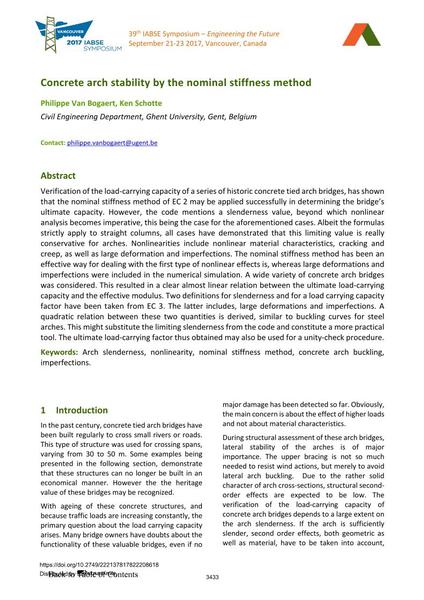Concrete arch stability by the nominal stiffness method

|
|
|||||||||||
Bibliographic Details
| Author(s): |
Philippe Van Bogaert
(Civil Engineering Department, Ghent University, Gent, Belgium)
Ken Schotte (Civil Engineering Department, Ghent University, Gent, Belgium) |
||||
|---|---|---|---|---|---|
| Medium: | conference paper | ||||
| Language(s): | English | ||||
| Conference: | IABSE Symposium: Engineering the Future, Vancouver, Canada, 21-23 September 2017 | ||||
| Published in: | IABSE Symposium Vancouver 2017 | ||||
|
|||||
| Page(s): | 3433-3438 | ||||
| Total no. of pages: | 6 | ||||
| Year: | 2017 | ||||
| DOI: | 10.2749/222137817822208618 | ||||
| Abstract: |
Verification of the load-carrying capacity of a series of historic concrete tied arch bridges, has shown that the nominal stiffness method of EC 2 may be applied successfully in determining the bridge’s ultimate capacity. However, the code mentions a slenderness value, beyond which nonlinear analysis becomes imperative, this being the case for the aforementioned cases. Albeit the formulas strictly apply to straight columns, all cases have demonstrated that this limiting value is really conservative for arches. Nonlinearities include nonlinear material characteristics, cracking and creep, as well as large deformation and imperfections. The nominal stiffness method has been an effective way for dealing with the first type of nonlinear effects is, whereas large deformations and imperfections were included in the numerical simulation. A wide variety of concrete arch bridges was considered. This resulted in a clear almost linear relation between the ultimate load-carrying capacity and the effective modulus. Two definitions for slenderness and for a load carrying capacity factor have been taken from EC 3. The latter includes, large deformations and imperfections. A quadratic relation between these two quantities is derived, similar to buckling curves for steel arches. This might substitute the limiting slenderness from the code and constitute a more practical tool. The ultimate load-carrying factor thus obtained may also be used for a unity-check procedure. |
||||
| Keywords: |
imperfections non-linearity Arch slenderness nominal stiffness method concrete arch buckling
|
||||
